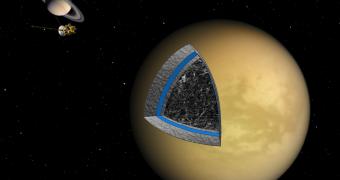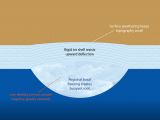The Cassini-Huygens probe is still discovering interesting and surprising things about Saturn and its moons, a decade into the mission.
New analysis of the gravitational field of Titan, one of the most intriguing moons in our solar system and one of the most Earth-like, despite some major differences, provided some strange results.
Cassini has been studying the strength of the gravitational field around Titan and, counterintuitively, found that the areas with the higher elevation had the lowest gravity.
Normally, elevated formations, like mountains on Earth, have more mass than the planes around them and thus have a greater gravitational pull. On Titan, the opposite is true, something that scientists believe is a sign that huge ice "bubbles" are trapped below the regular ice sheet.
Titan is the only place in the solar system with a weather system similar to Earth's. It rains on Titan, there are lakes and oceans, rivers and mountains.
Except for the rain, lakes and oceans are methane and the mountains are made of water ice since the moon is significantly cooler than our planet. Scientists believe that there's also a water ocean below the surface.
Now, the new findings, published in the Nature journal, suggest that the ice sheet is much thicker than previously believed. Ice is less dense than liquid water, explaining the gravity anomalies. Large ice formations would weigh less if the same volume was filled with water.
Scientists now believe that the ice sheet on Titan is 50 to 200 kilometers (30 to 120 miles) thick. The ice also has to be incredibly strong to keep the ice formations underneath. Since this ice weighs less than the water around it, it would tend to float to the surface. The surface ice sheet is what's keeping it down.
"It's like a big beach ball under the ice sheet pushing up on it, and the only way to keep it submerged is if the ice sheet is strong," Douglas Hemingway, the paper's lead author, said. "If large roots under the ice shell are the explanation, this means that Titan's ice shell must have a very thick rigid layer."
"If these findings are correct, a thick rigid ice shell makes it very difficult to have ice volcanoes, which some scientists have proposed to explain other features seen on the surface," NASA explained.
"They also suggest that convection or plate tectonics are not recycling Titan's ice shell, as they do with Earth's geologically active crust," it added.

 14 DAY TRIAL //
14 DAY TRIAL // 
